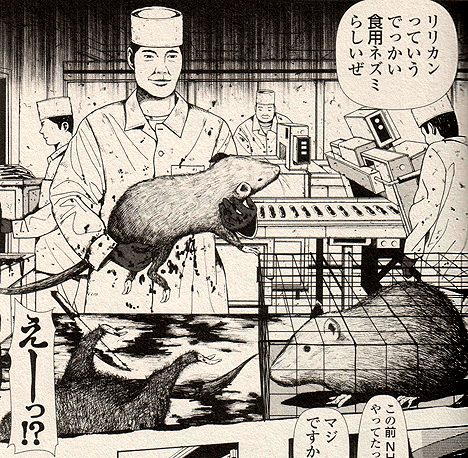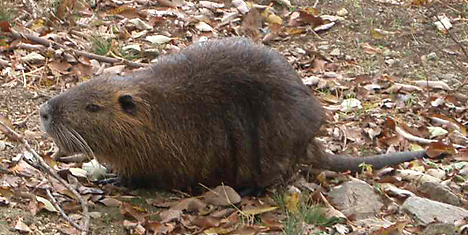Whether it's genetically-modified mutant chickens or burgers made of eyeballs, tales of tainted fast food are favorite fodder for urban legends. In Japan, one juicy rumor claims that a popular gyūdon (beef on rice) restaurant chain secretly substitutes its beef with the meat of the ririkan, a type of giant rat from Australia.

Where's the beef?
Considering that the ririkan is a nonexistent animal and there are no high-profile rodent farming operations in Australia, it is safe to assume this claim is false -- but how did the rumor get started?
One contributing factor might be that fast-food gyūdon is so incredibly inexpensive in Japan. Low prices raise suspicions among consumers, leading some to conclude that cheap, low-grade alternatives are being substituted on the sly.
But why giant rats from Australia?
Perhaps it is simply a case of two separate facts becoming jumbled in the public's mind. First, Australia is seen as a cheap and plentiful source of meat. More than 70% of Japan's beef imports now come from Down Under, and the price is low. Second, the consumption of large rodents is not unprecedented in Japan. The nutria (Myocastor coypus) -- a large, rat-like rodent native to South America -- served as a source of food in Japan during the lean war years.
The short-lived love affair with the nutria began in 1939, when the Japanese military imported 150 of the animals from France. A large-scale breeding effort was launched with the aim of creating a cheap supply of meat and fur, and by 1944 the nation's nutria population had reached an estimated 40,000.

Wild nutria in Hyōgo prefecture. Itadakimasu!
After the war, however, the demand for nutria meat and fur evaporated. Nutria farms shut down, and many animals were released into the wild, where they thrived. Decades later, nutria populations have become established in various parts of Japan, with the largest numbers found in western Honshū (though sightings have been reported as far east as Chiba prefecture). Today, the nutria is regarded as an invasive species that spoils the landscape, interferes with rice and barley farming, and threatens the habitat of an endangered dragonfly (Libellula angelina). In Okayama prefecture, which boasts the largest nutria population, as many as 2,000 of the animals are captured and killed each year in organized culling operations.
Nutria meat is no longer eaten in Japan, but the fact that the animal looks like a giant rat and once appeared on dinner tables might add a touch of plausibility to rumors of rodent flesh being served up at fast-food gyūdon restaurants (though it does nothing to explain the origin of the word "ririkan").
Whatever the source of the ririkan rumors, scholars suggest that talk of tainted fast food is an inevitable by-product of our modern-day appetite for convenient (and less healthy) food over traditional home-cooked meals. In addition to demonstrating the importance of fast food in our consumer-driven culture, these stories also reveal a lingering mistrust of the large corporations that manufacture the stuff we eat.
[Note: This is the latest in a series of weekly posts on Japanese urban legends. Check back next week for another report.]

zuza
Interesting explanation. I had no idea nutria is edible. In Poland urban legend is that that cheap "Chinese" food chains use rats or pigeons.
[]ENORCA
In Lithuania they say they use cats and dogs, hehe ;D
[]freedomwv
Rat meat in fast food!? Well, it is more than likely not true. Although, if it is true I would not be surprised.
[]stephen
Hey guys,
[]I love this "urban legends" theme. What a great idea. Keep up the good work.
corovo
here in south america lives the largest living rodent in the world: the capivara ( http://en.wikipedia.org/wiki/Capybara ). Old guys say it was quite normal to eat them in the country side.
[]corovo
http://imlost.com.br/wp-content/uploads/2009/08/capivara-como-animal-de-estima%C3%A7%C3%A3o.jpg
[]Sorcha
I thought most animal meat was edible, in fact, the higher the cute factor the tastier people seem to find it!
[]Jeff
The nutria makes complete sense. These, along with the invasive giant Asian carp now plaguing the Mississippi River system, are on the menu in a lot of restaurants along the river and especially in Louisiana.
[]MB
Tastes like chicken.
[]Jeanne
lol We have a nutria rat problem here in Louisiana too for the same reasons.
[]Lithuania
I don't think it's cats and dogs in Lithuania, probably just stray gypsies!
[]Todd
Remember when George has elaine buy him a big Russian hat and then he leaves it at a chicks house but elaine needs a reciept because she bought it on her J Peterman expense account so they buy a cheap hat in Central park but the accountant says it's fake and Jerry shakes it in the Kenny rogers Roasters and Elaine goes to the Orient to see Peterman whose doing his whole "DO you find my methods unsound?" routine and then he says he has to see this hat?
Well, it was Nutria that the accountant says the hat is made of.
[]Bakedpotatoes
NZ, the other 'Down Under', sells meat at very high prices to the Japanese. Ah, the joy of differing economies :D
[]Badger
Meat is meat. If it's "natural" and doesn't have any taint it's perfectly fine to eat it.
Trust me, after marching for hours in a drizzling rain, on a cool autumn day, with a 100lbs pack on your back, tinhat, rifle and the rest of the gear, you'll eat anything.
[]Podex
There is a macropod in Australia named Quokka that used to be described as big rats by Dutch explorers. The island they now almost exclusively live on even bears the name Rottnest (derived from "rattenest" which means rat's nest in Dutch). But I'm guessing Quokka meat was never exported to Japan. http://en.wikipedia.org/wiki/Quokka
[]